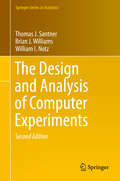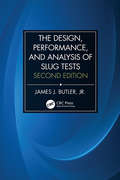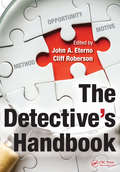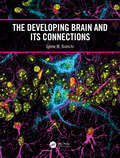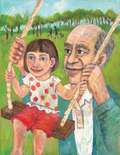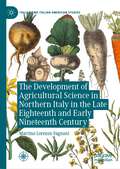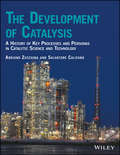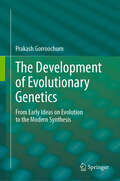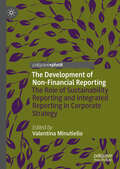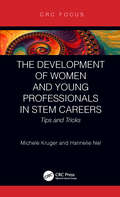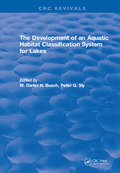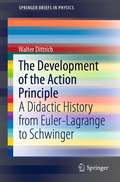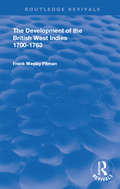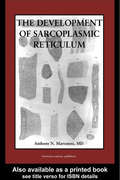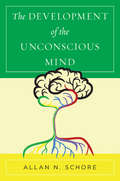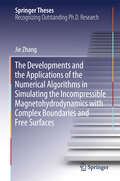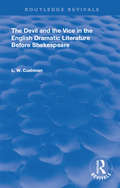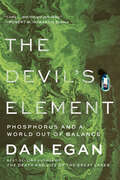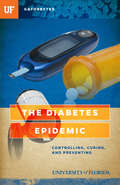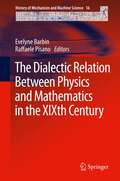- Table View
- List View
The Design and Analysis of Computer Experiments (Springer Series in Statistics)
by William I. Notz Thomas J. Santner Brian J. WilliamsThe Design and Statistical Analysis of Animal Experiments
by Simon T. Bate Robin A. Clark Simon T. Bate Robin A. ClarkWritten for animal researchers, this book provides a comprehensive guide to the design and statistical analysis of animal experiments. It has long been recognised that the proper implementation of these techniques helps reduce the number of animals needed. By using real-life examples to make them more accessible, this book explains the statistical tools employed by practitioners. A wide range of design types are considered, including block, factorial, nested, cross-over, dose-escalation and repeated measures and techniques are introduced to analyse the experimental data generated. Each analysis technique is described in non-mathematical terms, helping readers without a statistical background to understand key techniques such as t-tests, ANOVA, repeated measures, analysis of covariance, multiple comparison tests, non-parametric and survival analysis. This is also the first text to describe technical aspects of InVivoStat, a powerful open-source software package developed by the authors to enable animal researchers to analyse their data and obtain informative results.
The Design of Mammals
by John William ProtheroDespite an astonishing 100 million-fold range in adult body mass from bumblebee bat to blue whale, all mammals are formed of the same kinds of molecules, cells, tissues and organs and to the same overall body plan. A scaling approach investigates the principles of mammal design by examining the ways in which mammals of diverse size and taxonomy are quantitatively comparable. This book presents an extensive reanalysis of scaling data collected over a quarter of a century, including many rarely or never-cited sources. The result is an unparalleled contribution to understanding scaling in mammals, addressing a uniquely extensive range of mammal attributes and using substantially larger and more rigorously screened samples than in any prior works. An invaluable resource for all those interested in the 'design' of mammals, this is an ideal resource for postgraduates and researchers in a range of fields from comparative physiology to ecology.
The Design, Performance, and Analysis of Slug Tests
by James Johnson Butler, Jr.The slug test can provide valuable information for hydrogeologic investigations ranging from assessments of sites of groundwater contamination to the monitoring of well deterioration through time. Inappropriate procedures in one or more phases of a test program, however, can introduce considerable error into the resulting parameter estimates. The Design, Performance, and Analysis of Slug Tests, Second Edition remedies that problem by explaining virtually all there is to know regarding the design, performance, and analysis of slug tests. The first edition has become the standard reference for all aspects of slug tests; this revised edition updates the earlier material and expands the topical coverage with new developments that have come to the fore in the intervening years between editions. Features: Describes and demonstrates the eight key steps for the performance and analysis of slug tests Presents new methods for the analysis of tests in unconfined aquifers and in highly permeable settings Expands topical coverage of LNAPL baildown tests and slug tests in small diameter wells Includes numerous flow charts that illustrate easy-to-use strategies for selection of analysis methods, and field examples demonstrate how each method should be used to get the most out of test data Offers straightforward practical guidelines that summarize the major points of each chapter Written for practicing groundwater consultants and engineers, The Design, Performance, and Analysis of Slug Tests, Second Edition will enable readers to get more reliable information from slug tests and increase the utility of this widely-used field method.
The Desulfurization of Heavy Oils and Residua (Chemical Industries)
by James G. Speight"Second Edition expands and updates information on the technological aspects of refining heavy oils, residua, bitumen, and other high-sulfur feedstocks. Focuses on the range of next-generation refining processes."
The Detective's Handbook
by Cliff Roberson John A. EternoThe Detective‘s Handbook details the vital information law enforcement officers need to know to become better detectives. Since all essential aspects of detective work cannot be covered in a single volume, the editors have selected 20 of the most critical issues detectives face in their day-to-day work and present them in separate chapters.Using a
The Developing Brain and its Connections
by Lynne M. BianchiThe Developing Brain and Its Connections describes the processes of neural development from neural induction through synaptic refinement. Each chapter explores specific mechanisms of development and describes key experiments from invertebrate and vertebrate animal models. By highlighting experimental methods and explaining how hypotheses evolve over time, readers learn essential facts while strengthening their appreciation of the scientific method. Discussions of neurodevelopmental disorders and therapeutic approaches to them bridge basic science discoveries with the clinical aspects of the field. Descriptions of recent work by student researchers and medical residents demonstrate career pathways and options for those interested in pursuing any area neural development. With this distinctive approach, easy-to-follow writing style, and clear illustrations, The Developing Brain presents an accessible approach to neural development for undergraduate students. Related TitlesLuo, L. Principles of Neurobiology, 2nd edition (ISBN 9780815346050)Simon, S. A., series ed. Frontiers in Neuroscience https://www.routledge.com/Frontiers-in-Neuroscience/book-series/CRCFRONEUSCI Feltz, A., ed. Physiology of Neurons (ISBN 978-0-8153-4600-5)
The Developing Person Through the Life Span
by Kathleen Stassen BergerThis book is an authoritative, established text that engages students in the study of lifespan development from a chronological viewpoint.
The Development of Agricultural Science in Northern Italy in the Late Eighteenth and Early Nineteenth Century (Italian and Italian American Studies)
by Martino Lorenzo FagnaniThe late eighteenth century and subsequent Napoleonic Era witnessed a turning point in the establishment of agricultural science as a well-defined discipline in northern Italy. In this book, Martino Lorenzo Fagnani traces these developments by reviewing the correspondence of naturalists and agriculturists as well as the research plans of universities, academies, societies, institutes, and governments. He explores the establishment of a broad knowledge network encompassing all of Europe while also investigating the reasons behind the exchange of seeds, the establishment of spaces for experimentation such as scientific gardens and experimental fields, and the organization of specialized journals and monographs. This work represents an important contribution to the historiography of Italian agricultural science, filling a significant gap in our knowledge of related developments.
The Development of Catalysis: A History of Key Processes and Personas in Catalytic Science and Technology
by Adriano Zecchina Salvatore CalifanoThis book gradually brings the reader, through illustrations of the most crucial discoveries, into the modern world of chemical catalysis. Readers and experts will better understand the enormous influence that catalysis has given to the development of modern societies.• Highlights the field's onset up to its modern days, covering the life and achievements of luminaries of the catalytic era• Appeals to general audience in interpretation and analysis, but preserves the precision and clarity of a scientific approach• Fills the gap in publications that cover the history of specific catalytic processes
The Development of Evolutionary Genetics: From Early Ideas on Evolution to the Modern Synthesis
by Prakash GorroochurnThe books describes the historical development of evolutionary genetics, starting from early ideas on evolution and ending with the modern synthesis. It provides an extensive coverage of the history of both evolution and heredity, and gives detailed descriptions of the works of Lamarck, Darwin, Mendel, Näageli, Weismann, de Vries, Galton, Pearson, Bateson, Johannsen, Morgan, Fisher, Wright and Haldane, amongst many others. The book does not deal only with a description of historical work: it also analyses and critiques existing theories and evolutionary beliefs throughout history, and discusses several controversies between biologists.
The Development of Non-Financial Reporting: The Role of Sustainability Reporting and Integrated Reporting in Corporate Strategy
by Valentina MinutielloThis Book examines the topic of non-financial reporting, focusing on the two main types of reporting: Sustainability Reporting (SR) and Integrated Reporting (IR). It includes an overview of the research, with the aim of highlighting the diversity of approaches used by researchers as well as the multiplicity of facets that concern non-financial reporting. The chapters address the main macro-themes related to non-financial disclosure and attributable to the following categories: 1. The factors that influence the quality of non-financial reports; 2. The different types of non-financial disclosure (such as, for example, Circular Economy disclosure or Intellectual Capital Disclosure); 3. The motivations behind the adoption of non-financial communication, explained, for example, according to the legitimacy theory as the need for companies to improve or restore their reputation on the market. For each category, the volume provides examples of studies and starts the discussion for further necessary insights.
The Development of Science and Technology in Iran
by Abdol S. Soofi Mehdi GoodarziThis book examines the policies, conducts, and performances of organizations tasked with developing medium and high technologies in Iran. This collection assists readers in understanding the interaction between different players involve in the process of Iran's science, technology, and innovation development in specific technology areas over the last two decades. Chapters from expert contributors are organized into three themed parts: science and technology policy formulation and implementation, outcomes, and evaluation, including recommendations for further development of technological learning in Iran.
The Development of Women and Young Professionals in STEM Careers: Tips and Tricks (CRC Press Focus Shortform Book Program)
by Michele Kruger Hannelie NelThis book is fluent and systematic. The authors work through the fears and ambitions of young people new to STEM careers in the professional environment. Often, there is a lack of mentors, which leaves a young STEM practitioner exposed and doubting their own abilities. This book encourages young professionals and women in STEM careers to know that they are not alone and provides insight into their ability to deal with the stress of developing into a successful professional. Features Presents a method or vehicle to fast track young professionals and women in STEM Includes key issues that they should be aware of as they grow and develop in their education and field Describes how STEM career women are owners of their own path and provides an understanding of engineering and the business of consulting Conveys how young professionals and women in STEM can be aware of their own productivity and enjoy what they do and the career path they have selected This book is ideal for those new to the engineering, science, and consulting fields, including students in science and engineering education, administrators, libraries, those involved in leadership, organization behavior, human resources, STEM, and other areas as well.
The Development of an Aquatic Habitat Classification System for Lakes
by W.D.N. BuschIn the context of freshwater fisheries changing their strategies from the regulation of harvest and the enhancement of populations, to the creation and protection of habitats and the management of ecosystems, moves toward establishing an aquatic habitat classification system. Eight papers, from the February 1988 Symposium on the Classification and Inventory of Great Lakes Aquatic Habitats (the last in a series of Great Lakes Symposia), propose various classification approaches, most using a limited number of physical, chemical, and/or biological variables to produce some form of index. They also include overviews and summaries of the classification process.
The Development of the Action Principle: A Didactic History from Euler-Lagrange to Schwinger (SpringerBriefs in Physics)
by Walter DittrichThis book describes the historical development of the principle of stationary action from the 17th to the 20th centuries. Reference is made to the most important contributors to this topic, in particular Bernoullis, Leibniz, Euler, Lagrange and Laplace. The leading theme is how the action principle is applied to problems in classical physics such as hydrodynamics, electrodynamics and gravity, extending also to the modern formulation of quantum mechanics and quantum field theory, especially quantum electrodynamics. A critical analysis of operator versus c-number field theory is given. The book contains many worked examples. In particular, the term "vacuum" is scrutinized.The book is aimed primarily at actively working researchers, graduate students and historians interested in the philosophical interpretation and evolution of physics; in particular, in understanding the action principle and its application to a wide range of natural phenomena.
The Development of the British West Indies: 1700-1763 (Routledge Revivals)
by Frank Wesley PitmanOriginally published in 1917, this book is an investigation of industrial and social conditions in the British West Indies in the effort to reach a better understandinf of the part those islands played in the growth and dissolution of the British empire, including chapters on white labor in the sugar islands, the slave trade, and foreign markets for British sugar.
The Development of the Sarcoplasmic Reticulum
by Anthony MartonosiSarcoplasmic reticulum is a form of endoplasmic reticulum found in large quantities in mature muscle cells. Anthony Martonosi presents general information about the development and function of the sarcoplasmic reticulum within a framework of contemporary research on the molecular biology of biosynthetic and signaling processes. Focusing on the deve
The Development of the Unconscious Mind (Norton Series on Interpersonal Neurobiology #0)
by Allan N. SchoreAn exploration of how the unconscious is formed and functions by one of our most renowned experts on emotion and the brain. This book traces the evolution of the concept of the unconscious from an intangible, metapsychological abstraction to a psychoneurobiological function of a tangible brain. An integration of current findings in the neurobiological and developmental sciences offers a deeper understanding of the dynamic mechanisms of the unconscious. The relevance of this reformulation to clinical work is a central theme of Schore's other new book, Right Brain Psychotherapy.
The Developments and the Applications of the Numerical Algorithms in Simulating the Incompressible Magnetohydrodynamics with Complex Boundaries and Free Surfaces (Springer Theses)
by Jie ZhangThis thesis presents an accurate and advanced numerical methodology to remedy difficulties such as direct numerical simulation of magnetohydrodynamic (MHD) flow in computational fluid dynamics (CFD), grid generation processes in tokamak fusion facilities, and the coupling between the surface tension force and Lorentz force in the metallurgical industry. In addition, on the basis of the numerical platform it establishes, it also investigates selected interesting topics, e.g. single bubble motion under the influence of either vertical or horizontal magnetic fields. Furthermore, it confirms the relation between the bubble’s path instability and wake instability, and observes the anisotropic (isotropic) effect of the vertical (horizontal) magnetic field on the vortex structures, which determines the dynamic behavior of the rising bubble. The direct numerical simulation of magnetohydrodynamic (MHD) flows has proven difficult in the field of computational fluid dynamic (CFD) research, because it not only concerns the coupling of the equations governing the electromagnetic field and the fluid motion, but also calls for suitable numerical methods for computing the electromagnetic field. In tokamak fusion facilities, where the MHD effect is significant and the flow domain is complex, the process of grid generation requires considerable time and effort. Moreover, in the metallurgical industry, where multiphase MHD flows are usually encountered, the coupling between the surface tension force and Lorentz force adds to the difficulty of deriving direct numerical simulations.
The Devil and the Vice in the English Dramatic Literature Before Shakespeare (Routledge Revivals)
by L. W. CushmanOriginally published in 1900, this book was the first investigation of the devil and the Vice as dramatic figures, and a study of these figures led to a new view of the subject: it is, in brief, that the appearance of the devil in the non-dramatic as well as in the dramatic literature is limited to a definite range. As a dramatic figure the devil falls more and more into the background and the Vice is distinct in origin and function from the devil.
The Devil's Doctor: Paracelsus and the World of Renaissance Magic and Science
by Philip Ball“A vibrant, original portrait of a man of contradictions,” the Renaissance-era Swiss father of modern medicine (Publishers Weekly, starred review).Philippus Aureolus Theophrastus Bombast von Hohenheim, who called himself Paracelsus, stands at the cusp of medieval and modern times. A contemporary of Luther, an enemy of the medical establishment, a scourge of the universities, an alchemist, an army surgeon, and a radical theologian, he attracted myths even before he died. His fantastic journeys across Europe and beyond were said to be made on a magical white horse, and he was rumored to carry the elixir of life in the pommel of his great broadsword. His name was linked with Faust, who bargained with the devil.Who was the man behind these stories? Some have accused him of being a charlatan, a windbag who filled his books with wild speculations and invented words. Others claim him to be the father of modern medicine. Philip Ball exposes a more complex truth in The Devil’s Doctor—one that emerges only by entering Paracelsus’s time. He explores the intellectual, political, and religious undercurrents of the sixteenth century and looks at how doctors really practiced, at how people traveled, and at how wars were fought. For Paracelsus was a product of an age of change and strife, of renaissance and reformation. And yet by uniting the diverse disciplines of medicine, biology, and alchemy, he assisted, almost despite himself, in the birth of science and the emergence of the age of rationalism.Praise for The Devil’s Doctor“An enlivening portrait that will spark interest in [Paracelsus’s] role in the rise of science.” —Booklist“A true iconoclast, [Paraclesus] inhabited an ideological landscape somewhere between the medieval and the modern. Ball effectively places Paracelsus in the larger context of Renaissance magic and philosophy, and of a turbulent period. . . . Worth the effort.” —Kirkus Reviews
The Devil's Element: Phosphorus And A World Out Of Balance
by Dan EganA New Yorker Best Book of the Year "Lively…and thought-provoking.” —Robert W. Howarth, Science The New York Times best-selling author on the source of great bounty—and now great peril—all over the world. Phosphorus has played a critical role in some of the most lethal substances on earth: firebombs, rat poison, nerve gas. But it’s also the key component of one of the most vital: fertilizer, which has sustained life for billions of people. In this major work of explanatory science and environmental journalism, Pulitzer Prize finalist Dan Egan investigates the past, present, and future of what has been called “the oil of our time.” The story of phosphorus spans the globe and vast tracts of human history. First discovered in a seventeenth-century alchemy lab in Hamburg, it soon became a highly sought-after resource. The race to mine phosphorus took people from the battlefields of Waterloo, which were looted for the bones of fallen soldiers, to the fabled guano islands off Peru, the Bone Valley of Florida, and the sand dunes of the Western Sahara. Over the past century, phosphorus has made farming vastly more productive, feeding the enormous increase in the human population. Yet, as Egan harrowingly reports, our overreliance on this vital crop nutrient is today causing toxic algae blooms and “dead zones” in waterways from the coasts of Florida to the Mississippi River basin to the Great Lakes and beyond. Egan also explores the alarming reality that diminishing access to phosphorus poses a threat to the food system worldwide—which risks rising conflict and even war. With The Devil’s Element, Egan has written an essential and eye-opening account that urges us to pay attention to one of the most perilous but little-known environmental issues of our time.
The Diabetes Epidemic: Controlling, Curing, and Prevention
by University of Florida Leonora LaPeter AntonThe University of Florida has an ambitious goal: to harness the power of its faculty, staff, students, and alumni to solve some of society’s most pressing problems and to become a resource for the state of Florida, the nation, and the world. The Diabetes Epidemic explores the complicated landscape of diabetes research and offers a glimpse of the extraordinarily difficult, and sometimes serendipitous, ways in which breakthroughs occur. At the University of Florida Diabetes Institute more than 100 faculty members are working on education, research, prevention, and treatment. Their fields are diverse—genetics, endocrinology, epidemiology, patient and physician education, health outcomes and policy, behavioral science, and rural medicine—but their goal is the same. Jump into the trenches with the doctors, scientists, and research nurses at the Diabetes Institute to learn about the challenges associated with developing treatments. Meet a brother who is helping his sister by participating in one of the largest studies ever undertaken of people at risk for Type 1 diabetes. Visit the largest open-access repository of diabetic pancreases in the world, where the most studied is that of a 12-year-old boy who had Type 1 diabetes for only a year. Spend time with one of the foremost diabetes researchers as he decides which pancreases to study, deploys experimental projects to answer new questions, and struggles to fund additional investigations. Discover why Type 2 diabetes is affecting more and more people and how some of them control it, and learn about a few of the most promising Type 2 treatments currently under study. While a cure has not yet been found, the researchers at UF’s Diabetes Institute are working to improve the lives of the estimated 415 million people currently suffering from the disease worldwide. The stories chronicled in GATORBYTES span all colleges and units across the UF campus. They detail the far-reaching impact of UF’s research, technologies, and innovations—and the UF faculty members dedicated to them. Gatorbytes describe how UF is continuing to build on its strengths and extend the reach of its efforts so that it can help even more people in even more places.
The Dialectic Relation Between Physics and Mathematics in the XIXth Century
by Raffaele Pisano Evelyne BarbinThe aim of this book is to analyse historical problems related to the use of mathematics in physics as well as to the use of physics in mathematics and to investigate Mathematical Physics as precisely the new discipline which is concerned with this dialectical link itself. So the main question is: When and why did the tension between mathematics and physics, explicitly practised at least since Galileo, evolve into such a new scientific theory? The authors explain the various ways in which this science allowed an advanced mathematical modelling in physics on the one hand, and the invention of new mathematical ideas on the other hand. Of course this problem is related to the links between institutions, universities, schools for engineers, and industries, and so it has social implications as well. The link by which physical ideas had influenced the world of mathematics was not new in the 19th century, but it came to a kind of maturity at that time. Recently, much historical research has been done into mathematics and physics and their relation in this period. The purpose of the Symposium and this book is to gather and re-evaluate the current thinking on this subject. It brings together contributions from leading experts in the field, and gives much-needed insight in the subject of mathematical physics from a historical point of view.
